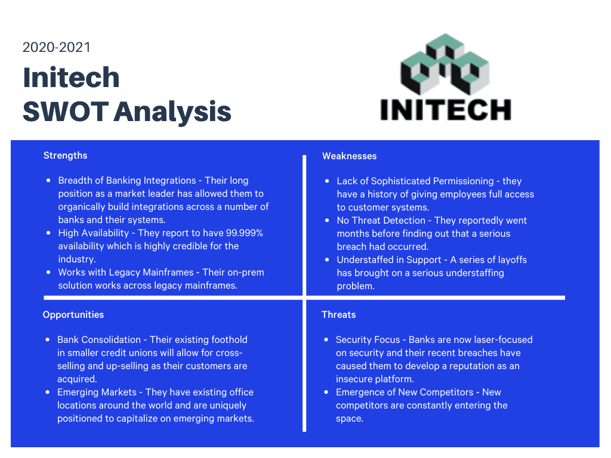The new year is right around the corner. If you haven’t already, you’re likely about to kick-off your 2021 planning. A lot has happened in 2020 that has impacted businesses across the globe and changed how many of us run our businesses. For the competitive intelligence (CI) professionals out there, how are you adjusting your CI program plans? How are you prioritizing the many ways you can support competitive strategies across the company? How are you aligning your CI initiatives with the business’s key goals for the coming year? When it comes to building your competitive intelligence program plan for the new year, these 15 questions will help you establish the foundation of a winning competitive intelligence plan.
Part 1: Competitive Shifts from the Past Year
The first step in establishing your 2021 CI plan is to review the competitive and market shifts from the past year. This will provide a backdrop to understand where the market is going and how the company has fared in the changing marketplace. In this section, answer the following questions:
- What were the major competitive events from the last year, and what impact did they have on the market? Recap events such as acquisitions, product launches, or leadership changes from both your company and your competitors. What impact did it have on market share, brand perception, revenue, or other KPIs? What was the feedback from the market on each of these events, and how did that affect your success against your competitors? It also may be helpful, depending on your industry, to note how your competitors’ reacted to the COVID-19 pandemic. How well did they pivot? How did their business shift over the last year?
- Which competitors grew in prominence, and which new competitors emerged? In other words, how did the actual players change over the course of the year? Are there new competitors that are now contenders, while other competitors closed down or merged?
- What direction are your competitors going? Based on the competitive shifts from the last year, where are your competitors going? Are they investing in new verticals, new technology, or other areas to get an edge? Look to signals like a series of product investments, recent hires, or new messaging rolled out on their website.
- How did our competitive strategy perform? Throughout the year, your company made many decisions aimed at winning in a competitive market. How effective was that strategy? What were the key activities completed, and how did they perform? What investments were made, and how great was the return?
Part 2: SWOT Analysis
The next step is to analyze the competitive landscape expected for the coming year. Leveraging a SWOT analysis allows you to identify opportunities and threats, while also articulating your company’s strengths and weaknesses. Here are the questions to address in your SWOT analysis:
- What are your company’s strengths? Identify your company’s unique strengths that allow you to compete and win in your market. Strengths can touch on product advantages, brand strengths, or even operational processes that give you a leg up in the market.
- What are your company’s weaknesses? Identify your company’s gaps that impact your success in the market. Being honest about these weaknesses allows you to address gaps, make necessary investments, or even change the rules of the game to favor your strengths instead of your weaknesses.
- What are the new opportunities for the coming year? Based on recent and anticipated market shifts, determine potential opportunities for business growth. Perhaps there’s a competitor losing market share whose customers are ripe for the taking. Or perhaps there’s new technology that can open up unique functionality. Outlining these opportunities will set up a productive conversation about where and how to invest CI efforts.
- What potential threats exist going into the new year? Once again, based on recent and anticipated market shifts, determine threats to your position in the market. This could include an emerging competitor gaining traction or a set of competitors moving in on your differentiated product features. Outlining these threats will allow you to plan ahead and determine what competitive strategies are needed.

Part 3: Resources to Support CI Goals
Once you have an understanding of the competitive landscape in the last year and where there are opportunities going forward, it’s time to determine the resources needed to achieve your CI goals. Dig into the following questions in this section of your plan:
- What people are needed to get on board? Do you need to expand your CI team to address a wider range of competitors? Do you need different skill sets on your CI team to achieve your goals? Have you built a competitive intelligence culture within your organization?
- What tools or technology do you need? As you invest further in your CI efforts, what can be improved with tools or technology? What technology do you want to bring on board, and why?
- How much budget is needed to secure the above resources? What budget is needed for the necessary hires and necessary technology? Identifying these ballpark numbers can set the right expectations about the level of employees and technology needed.
- How does the business need to support CI to be effective? What type of input or involvement do you need, and from whom, to have the maximum impact? Are there any organizational or cultural shifts that need to happen?
- Which business investments are needed to execute a CI strategy? Are there particular investments in product, marketing, or elsewhere needed to deliver on chosen strategies to get a competitive advantage? Outline them to set expectations about the business decisions needed to follow through on your competitive strategy.
Part 4: Alignment with Business Goals
Building a CI program plan provides benefits to the CI team as well as those outside the CI team. Likely this plan will be shared with other stakeholders - executive leadership, key CI audiences, as well as collaborators. That’s why it’s critical to articulate how this plan aligns with overall business goals - doing so will allow other audiences to relate this work to what matters most to them. While there may not be many questions to answer in this section, they are among the most important to address:
- What are the key performance indicators (KPIs) used to measure the CI program? What metrics will you turn to in order to measure success?
- How does the CI program support overall business KPIs? Connect the dots between CI success and business success.
Part 5: Summary
As you round out your CI program plan, it’s time to summarize all of the key points. This includes summarizing key competitive shifts from the past year, opportunities and threats for the coming year, key priorities and metrics aligned with them, and any resources needed to succeed. Diving into each of these areas gives both competitive intelligence professionals and their stakeholders visibility into competitive shifts and the strategies needed to win in complex markets.

Related Blog Posts
Popular Posts
-
 The 8 Free Market Research Tools and Resources You Need to Know
The 8 Free Market Research Tools and Resources You Need to Know
-
 6 Competitive Advantage Examples From the Real World
6 Competitive Advantage Examples From the Real World
-
 24 Questions to Consider for Your Next SWOT Analysis
24 Questions to Consider for Your Next SWOT Analysis
-
 How to Create a Competitive Matrix (Step-by-Step Guide With Examples + Free Templates)
How to Create a Competitive Matrix (Step-by-Step Guide With Examples + Free Templates)
-
 How to Measure Product Launch Success: 12 KPIs You Should Be Tracking
How to Measure Product Launch Success: 12 KPIs You Should Be Tracking





